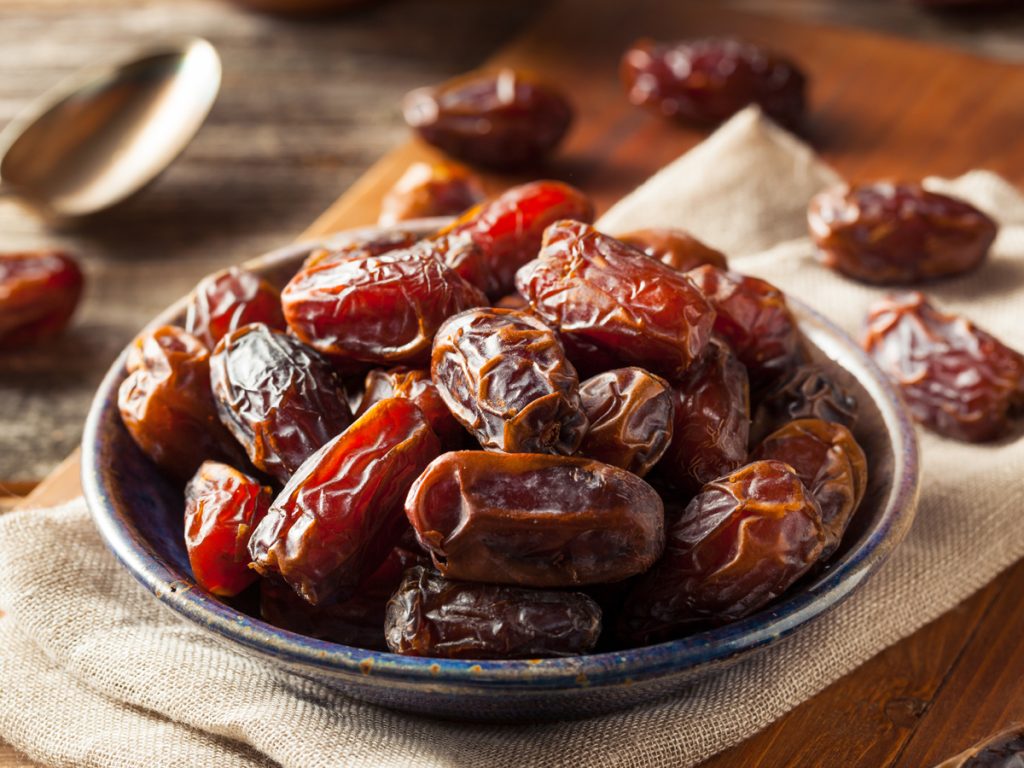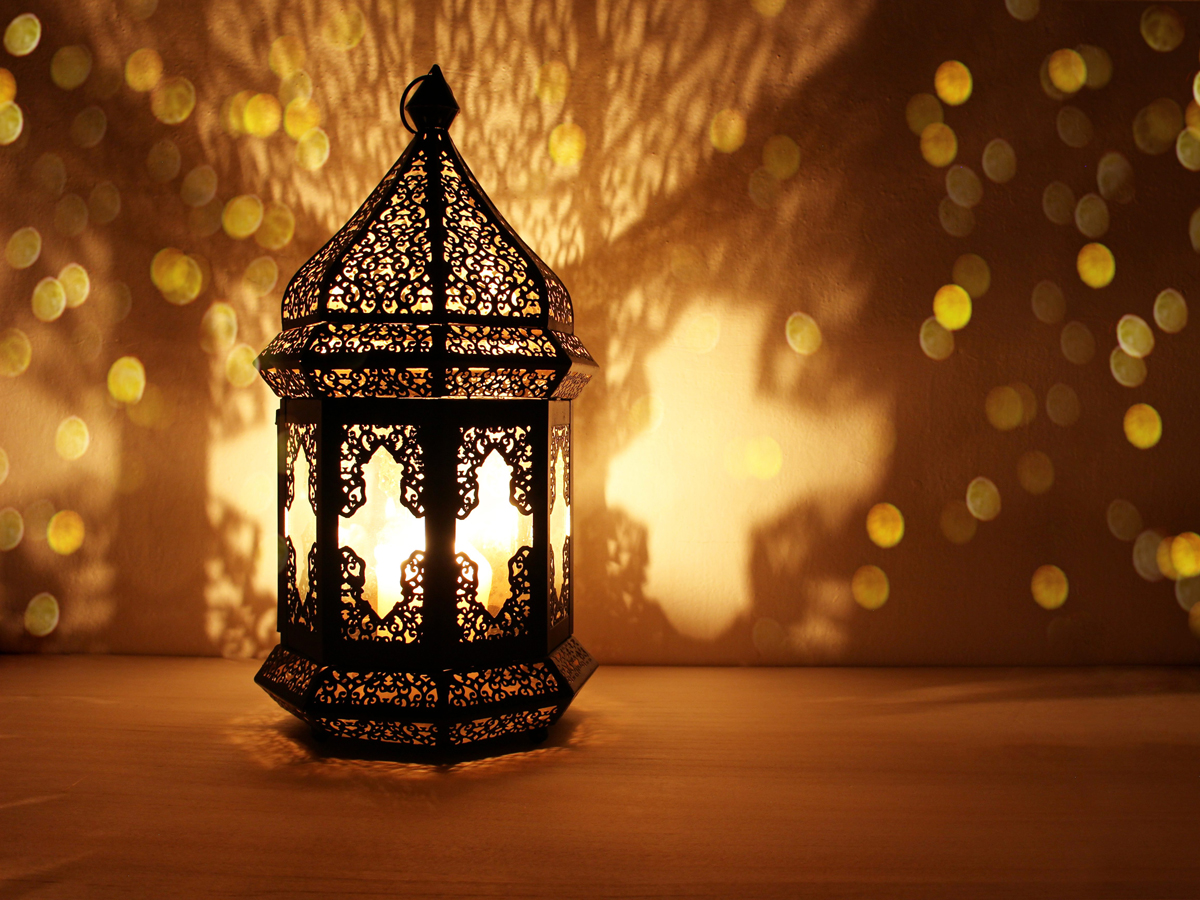There are many iftars in Riyadh for Ramadan 2022. That leaves plenty of opportunities to enjoy popular iftar dishes. There is a vast variety of must-try iftar dishes from starters to mains to desserts and drinks. Everyone likely already has a few favourites, but if you’re heading to an iftar tent this Ramadan, now is the perfect opportunity to broaden your horizons.
Here are the iftar dishes you should be making a beeline for once the sun goes down.
JUMP TO:
Iftar dishes: Starters
Dates

These sugary, almost caramel tasting fruits have been the fast-breaker of choice for many moons gone by. Indeed, it’s a tradition lifted straight from the Quran, that the highly sugary bites be the first to enter the mouth. Both practical (as the natural high sugar content of fruit gives the blood sugar the kick it needs) and symbolic – the date palm tree is known to be a representation of prosperity in the Middle East – this is where any good iftar begins.
Shorbat adas

A warm hug from the inside, this Levantine take on lentil soup is a gentle and comforting way to start a meal. Made from red lentils, and turmeric with plenty of onion and garlic, it’s more flavoursome than you might think. Known for their exceptional nutritional content, lentils are low in fat, high in protein and full of iron, this a particularly nourishing option to consume after a day of fasting.
Harira

Since fasting over long periods of time causes the stomach to contract, it’s important to allow it to relax before getting stuck into the feast proper. This Moroccan-style soup of lamb, lentils and chickpeas is the ideal tool for the job. As well as warming the digestive system and prepping it for action, it’s also a rich source of fibre and protein. The fact that it’s also particularly tasty, then, comes as a happy bonus.
Kibbeh

Derived from the Arabic word ‘kubbah’ which means ball, ‘kibbeh’ is thought to have originated in Syria but, as you’ll know if you’ve been here for a while, it’s widely eaten across the GCC. A hugely popular dish year-round, these bite-sized snacks are made by pounding bulgur wheat with finely minced lamb or beef. Their size and filling-factor make them the perfect snack to share with friends over a long evening of iftar eating.
Fattoush

If salad doesn’t usually get your taste buds going, try this one that includes lashings of fried bread on top – need we say more? A simple combination of fresh ingredients tossed with an oily, often tart lemon juice dressing and a decent serving of fried khubtz (Arabic bread) this is salad, made fun.
Tabbouleh

Proof that the humble parsley sprig has more to offer than you might think, this fragrant yet highly palatable bowl is the perfect side to accompany meaty dishes. If you thought parsley was reserved for a garnish, try it tossed with the bulgur grain, fresh tomatoes, mint and onion to see why tabbouleh really words.
Samosas

It’s a truth universally acknowledged, that anything deep fried is delicious. So it makes total sense that these triangular pastry treats make their way in to almost every iftar spread. Fried to a perfect golden-brown these pastry cases are often filled with spiced meats or potatoes and, are served up with some type of appealing dipping chutney.
Malfoof

A lighter version of the stuffed vine leaves found on Lebanese mezze platters, these bite-size morsels consist of cabbage leaves wrapped around a variety of fillings – usually rice or bulgur wheat. Some spreads will even present their malfoof on a larger scale – hollowing out an entire cabbage before stuffing it with goodies and serving it up with a minty sauce.
Vine leaves

A starter that falls underneath the umbrella of dolma dishes (meaning stuffed vegetables) vine leaves are served as part of a cold mezze platter. The perfect picky food, they’re made by taking the young leaves of the grapevine and stuffing them with rice and or meats and cooked in masses of olive oil.
Iftar dishes: Main courses
Haleem

After a day of not eating, a wholesome stew is a good option. Haleem is a high-calorie dish packed full of fibre and carbohydrates. Consumed across the Indian subcontinent, Middle East and Central Asia, you’ll find it made with some type of meat, lentils, rice and plenty of onion which gives it a deliciously inviting aroma.
Lamb ouzi

Ouzi is often presented as the centrepiece of an iftar feast. So even if you’re not fasting, this filling dish – similar in style to an Indian biryani – is a must-try. Traditionally, the animal is spit-grilled whole, having been stuffed with a mixture of spiced rice and nuts. You’ll be back to the buffet for seconds, trust us.
Harees

A traditional Emirati dish of boiled wheat and tender, slow-cooked lamb, which is found on iftar tables across the Gulf. Though it’s not much to look at (imagine a sloppy mass the colour and consistency of porridge), it’s just the ticket for putting back into the diet what fasting takes out, providing plenty of protein and slow-release energy that’ll keep the appetite in check through ‘til suhoor.
Kousa mahshi

Though its origin is unclear (Lebanon makes a noisy claim to the creative rights, as do Syria and Egypt), the one thing we know about this dish of yoghurt-topped, meat-stuffed zucchini is that those who hang around too long will find the serving dish bare. They’re presented halved or whole, depending on where you’re eating, while some add rice, mint or garlic into the mix.
Mixed grill

Grilled meats and kebabs are common place at iftar celebration, and why wouldn’t they be? A staple food in the Middle East, the meat is richly spiced and grilled to succulent perfection before being served with salads and French fries. Plus, the meats go perfectly with hummus and tahini, if you’re looking for something to dip yours into.
Chicken jalfrezi

You’re highly likely to find a few traditional Indian dishes on an iftar spread, and for good reason. Eaten throughout the Indian-subcontinent, jalfrezi is a frequent feature during Ramadan. A stir-fried chicken curry made with a thick-spicy sauce and served on a bed of rice, it’s warming and downright delicious.
Iftar dishes: Desserts and drinks
Kunafeh

This sweet, cheese-based pastry represents the Palestinian contribution to the iftar table. Though it’s often eaten for breakfast in Levantine nations, in the UAE you’ll find it in the dessert section, usually surrounded by excitable children wielding ladles of heavy syrup. Good for one last burst of energy, this will go nicely with your Arabic coffee.
Baklava

Turkey’s part in the banquet comes in the form of rich nuggets of filo pastry, flavoured with rosewater syrup and chopped nuts. You’ll no doubt have encountered baklava before, but only during Ramadan does the truly special stuff come out to play.
Umm Ali

Egypt’s answer to bread and butter pudding, this creamy dish is always hit on iftar spreads. Those almonds, pine nuts and pistachios are packed with the vitamins and minerals your body needs. A little goes a long way; this is one deceptively mighty dessert.
Drinks
Vimto

Originally from Manchester, UK, this sugary drink became associated with Ramadan after it made its way to Saudi Arabia in 1927. The high-sucrose content of the purple coloured cordial means it’s the perfect supplement to a filling meal after a long fast.
Mango lassi

A thick yogurt, almost smoothie-like drink made with fresh mango. Of Indian origin it is touted for its digestion-aiding qualities. During Ramadan you might find it garnished with pistachios and almonds, or blended up with dates – making it even sweeter on the tongue.
Jallab

This diluted drink is made by mixing the syrup crafted from grape molasses and mixing with water. Usually the recipe calls for spoonfuls of pine nuts and raisins to be mixed into the brown liquid so you’ll find it served with a teaspoon, so you can scoop these out when the drink is finished.
Tamer Hindi

If you’re feeling dehydrated, opt for a glass of tamer hindi alongside your dinner. Left to soak overnight, tamarind is combined with sugar, rose water, ginger and water – sweet and refreshing at the same time.









